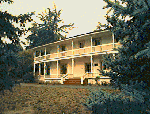the john muir exhibit - john_muir_national_historic_site - martinez adobe
The Martinez Adobe
 Thousands of acres were owned by individual
families under the Spanish and Mexican land grant
systems. The original Martinez grant contained over
17,000 acres and reached past the town of Pinole
southwest of Alhambra Valley. (Don Vincente
Martinez, son of the commandante of the Presidio
of San Francisco, built this house of adobe bricks
around 1849.)
Thousands of acres were owned by individual
families under the Spanish and Mexican land grant
systems. The original Martinez grant contained over
17,000 acres and reached past the town of Pinole
southwest of Alhambra Valley. (Don Vincente
Martinez, son of the commandante of the Presidio
of San Francisco, built this house of adobe bricks
around 1849.)
The foundation of the Martinez Adobe is rough
stone, while the walls are sun-dried adobe brick
ranging in thickness from twenty-four to thirty
inches. The roof was covered with shingles of
either cedar or redwood.
Don Vicente Martinez lived in his adobe only
four years before he sold it to Edward Franklin, the
first of a series of owners who would change the
land again.
 Dr. John Strentzel, father-in-law of John
Muir, purchased the adobe from an Australian,
Thomas Redfern, in 1874. Dr. Strentzel, often
called the father of California horticulture, soon
replaced cattle with fruit trees of many varieties.
Dr. Strentzel used the adobe as a store room and as
a residence for his foremen.
Dr. John Strentzel, father-in-law of John
Muir, purchased the adobe from an Australian,
Thomas Redfern, in 1874. Dr. Strentzel, often
called the father of California horticulture, soon
replaced cattle with fruit trees of many varieties.
Dr. Strentzel used the adobe as a store room and as
a residence for his foremen.
Contrary to legend, John Muir and his wife
never lived in the Martinez Adobe, but it was the
home of his elder daughter, Wanda, and her husband,
Thomas Hanna. John Muir would often eat meals at
the adobe and find time to play with his
grandchildren.
The coming of heavy industry to Martinez in
1914, the year of Muir's death, saw the beginning
of the end of orcharding in the lower Alhambra
Valley. Population growth meant that the land had
greater monetary value for homes than for
orchards, and the land changed again.
By the 1960s, open farmland was replaced
with houses and streets. Concerned citizens
organized themselves to preserve a small sample
of the past before it vanished, and in 1964, the
adobe became part of the John Muir National
Historic Site.
Source:
John Muir National Historic Site
Home
| Alphabetical Index
| What's New & About this Site